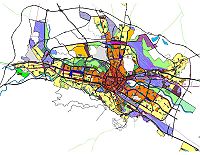
Photo from wikipedia
Family forests comprise a significant portion of total forest land area in the southern United States and their owners frequently have multiple, competing objectives. This research evaluated the effectiveness of… Click to show full abstract
Family forests comprise a significant portion of total forest land area in the southern United States and their owners frequently have multiple, competing objectives. This research evaluated the effectiveness of functional zoning based on site index on forest sizes relevant to family forest owners. A total of fifty family forests were randomly selected from twenty-five counties in the East Texas Pineywoods region. Timber production and northern bobwhite habitat (Colinus virginianus) habitat were used as proxies for competing objectives. It was found that 80% of family forest parcels had sufficient site index heterogeneity to benefit from functional zoning. For forest parcels that could benefit from functional zoning, the benefit in terms of increased land expectation value (LEV) was not found to be dependent on parcel size. On average, this approach increased the LEV $32/ac at a 3% discount rate, $16/ac at 5%, and $9/ac at 7%. This zoning approach supports multiple objectives while minimizing the economic impact of the nonrevenue objectives. Study Implications: This study illustrates an approach to managing a forest for multiple competing objectives typical of the US South. The study findings show that many small forest tracts can benefit from functional zoning based on site index and could therefore be of interest both to family forest landowners and forest managers. Findings are also useful in providing the impact of different management approaches on the land price as measured by LEV.
Journal Title: Journal of Forestry
Year Published: 2023
Link to full text (if available)
Share on Social Media: Sign Up to like & get
recommendations!